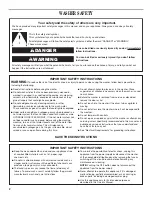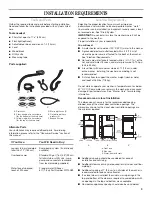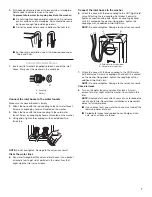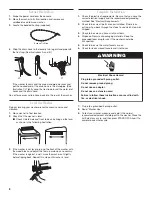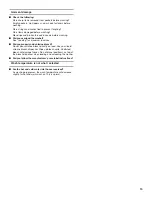
10
3.
(OPTIONAL STEP) Pour measured liquid fabric softener into
the liquid fabric softener dispenser. Softener is added
automatically during the rinse portion of the cycle.
Dilute liquid fabric softener by filling the dispenser with warm
water until liquid reaches the top line marked inside the
dispenser.
■
Do not spill or drip any fabric softener on the clothes.
■
Use only liquid fabric softener in this dispenser.
NOTE:
Do not wash clothes with the fabric softener dispenser
removed.
4.
Close the washer lid. Washer will not fill, agitate or spin with
the lid open.
5.
Press the WATER LEVEL button to select the correct setting
for your wash load and the type of fabric being washed. For a
medium load the indicator light is on, for a large load the light
is off.
■
Choose a water level that allows the load to move freely
for best fabric care. See “Loading.”
■
You may change the water level setting while the washer
is filling. If you change from high to medium but the water
has filled past medium, you will get medium with the next
fill.
6.
Set the water temperature for the type of fabric and soils
being washed. Use the warmest wash water safe for fabric.
Follow garment label instructions.
Press the WASH/RINSE TEMPERATURE button to set the
wash temperature. For a Hot wash the top light is on, for Cold
the bottom light is on, for Warm both lights are on. All cycles
use a cold rinse.
Selecting Water Temperatures
Water Temp
Use for
Hot
Whites and pastels
Heavy soils
Warm
Bright colors
Moderate to light soils
Cold
Colors that bleed or fade
Light soils
NOTE:
In wash water temperatures colder than 70ºF (21ºC),
detergents do not dissolve well. Soils can be difficult to
remove. Some fabrics can retain wear wrinkles and have
increased pilling (the formation of small lint-like balls on the
surface of garments).
7.
Press the CYCLE SELECTOR button to select the wash cycle
you want. See “Cycles.”
8.
Press START/OFF.
To stop or restart your washer
■
To stop the washer at any time, lift the lid, cycle will
pause.
■
To restart the washer, close the lid, cycle will resume.
Cycles
This section describes the available wash cycles and will help you
make the best cycle selections for your wash loads. Each cycle is
designed for different types of fabric and soil levels.
■
The washer pauses briefly throughout each cycle. These
pauses are normal. Refer to “Normal Sounds” to learn more
about the sounds you may hear during a wash cycle.
■
Refer to “Understanding Washer Cycles” to learn what
happens during a wash cycle.
Cottons
Use this cycle to get 18 minutes of wash time for sturdy or heavily
soiled loads. Wash combines high-speed agitation and high-
speed spin for maximum soil removal.
Normal
Use this cycle to get 12 minutes of wash time for normally soiled
cottons and linens. Wash combines medium-speed agitation and
high-speed spin to shorten drying time.
Easy Care
Use this cycle to get 10 minutes of wash time. Use for
wrinkle-free and permanent press items, and knits. Wash
combines medium-speed agitation and high-speed spin to
shorten drying time.
Delicates
Use this cycle to get 6 minutes of wash time for lingerie and
loosely knit items. Wash combines low-speed agitation for gentle
soil removal, and high-speed spin to shorten drying time.
Understanding Washer Cycles
When a cycle is selected, the washer lid is closed, and
START/OFF is pushed, the washer fills (to the selected load size)
before agitation and timing start. The lid must be closed during
operation. The washer will not fill, agitate or spin with the lid open.
NOTE:
The washer pauses briefly throughout each cycle. These
pauses are normal for washer operation.
WASH
RINSE
1. Fill
1. Fill
2. Wash selected
time
2. Rinse
3. Drain
No agitation
3. Drain
No agitation
4. Spin
4. Spin
5. Off
Содержание Spacemaker WSKS3040EWW
Страница 16: ...16 NOTES ...


